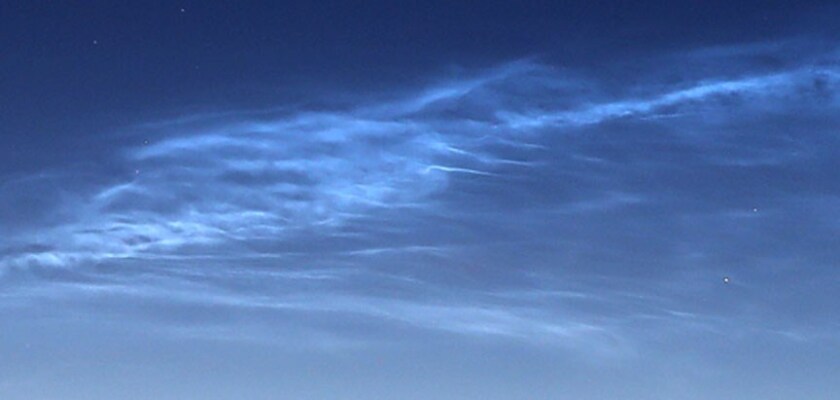The start of summer brings lush growth, heat, mosquitoes, the Milky Way and special clouds, too. Not just those incredible thunderclouds, also called cumulonimbus, that bubble to heights of 39,000 feet (12,000 meters) but also a peculiar twilight variety called noctilucent or night-shining clouds.

Their wispy textures resemble cirrus clouds, sometimes called mares’ tails, that streak the blue sky on a fine afternoon. Cirrus form when water vapor condenses as ice crystals on tiny particles called “condensation nuclei.” They include dust, salt from ocean spray, and soot from forest fires, industry and car exhaust. Cirrus are the highest of the common clouds and are located near the top of the troposphere — the lowest layer of the atmosphere — between 16,000 and 45,000 feet (5,000 to 14,000 meters).
ADVERTISEMENT

Noctilucent clouds (NLCs) are similar to other clouds but differ in several important ways. While they also form by condensation, they’re much, much higher. They appear at an altitude of 51 miles high near the top of the mesosphere , the coldest layer of Earth’s atmosphere where temperatures hover around -130° F. Water vapor wafted upwards from the lower atmosphere, perhaps assisted by gravity waves spawned by weather fronts, crystallizes around “meteor smoke,” fine particles of soot remaining when a meteoroid burns up in the atmosphere.
NLCs have seasons and are typically visible between latitudes 50° and 70° north (Canada, northern Europe, Russia) from late May through mid-August. The southern hemisphere also has an NLC season from November through February at similar latitudes south. It may sound counter-intuitive, but the mesosphere is coldest during the summer months. The extra chill increases the water vapor condensation rate, promoting cloud formation.

The clouds are visible from 1-2 hours after sunset and 1-2 hours before sunrise in mid-twilight after the other clouds are in shadow. Because of their extreme altitude noctilucent continue to shine well into twilight. While resembling cirrus clouds they’re different, often twisting into strands that look like frayed rope. A closer look with binoculars will reveal delicate ripples and whorls fanning away from the strands.
Color sets them apart, too. NLCs glow silvery-white in early twilight, but as the sky darkens and the stars start to come out they glow an ethereal shade of blue. The ozone layer is responsible for the color. Sunlight reflected off the clouds must first pass through the ozone layer in the stratosphere before it reaches our eyes. Ozone absorbs the yellow, orange and red light but lets blue pass through.
ADVERTISEMENT

Noctilucent clouds were first reported in 1885 and visible infrequently from higher northern latitudes. In recent years sightings have become more common and from locations much further south including Kansas, Las Vegas, Denver and even Los Angeles. Where I live in northern Minnesota at latitude 47° north we typically see a couple nice displays each summer. Many researchers think the increase in the extent and frequency of NLCs may be linked to climate change, coupled with the ups and downs of the 11-year solar cycle.

Methane gas from natural and human sources can work its way into the mesosphere where it combines with certain ions to form water vapor. With more vapor available more clouds can form. Carbon dioxide (CO 2) traps heat and warms the lower atmosphere but at the altitude of the mesosphere it radiates heat away, lowering temperatures, which can further increase the rate of cloud formation.
The sun also gets into the act. When it’s most active at the peak of the 11-year sunspot cycle it radiates more ultraviolet (UV) light, warming the outer atmosphere and decreasing the frequency of noctilucent clouds. Around solar minimum, where we find ourselves now, the sun’s UV output drops and the outer atmosphere cools, which promotes NLC formation.

ADVERTISEMENT
To my knowledge the first appearance of noctilucent clouds over my region occurred on June 9. Since that date I’ve been on an NLC vigil. Each clear or partly cloudy evening I drive to a spot with a wide open of the northern sky. From higher latitudes the clouds can fill the entire north but from “the 40s” you’re best to look low in the north a fist to a fist-and-a-half (10°-15°) above the horizon.

Here, the sun sets around 9:05 p.m. so I watch between 10 and 11 p.m., but I could just as easily go out before sunrise from 3-4 a.m. So far I’ve seen one faint display (June 13) and one bright, super-obvious one on June 21. On both occasions the NLCs reached peak brightness around 10:15-30 p.m.
Want to start a vigil, too? Go to www.timeanddate.com/sun/ to find your local sunset and sunrise times and plan to watch between 1-2 hours after sunset or before sunrise. The further north you live the better your chances of seeing these elusive beauties, but don’t let latitude stop you. No matter where you live keep an eye open for these curious clouds that hover at the edge of space.






